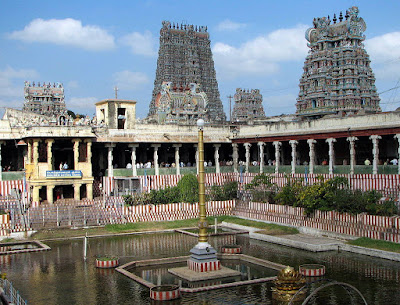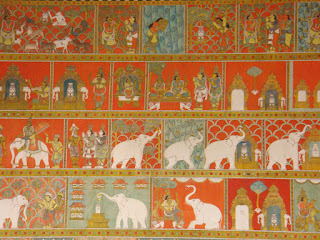Meenakshi Temple
Meenakshi Temple
 |
| Meenakshi Temple |
About
Meenakshi Temple, also referred to as Meenakshi Amman or Minakshi-Sundareshwara Temple, is a historic Hindu temple located on the southern bank of the Vaigai River in the temple city of Madurai, Tamil Nadu, India. It is dedicated to Meenakshi Temple, a form of Parvati, and her consort, Sundareswar, a form of Shiva. The temple is at the center of the ancient temple city of Madurai mentioned in the Tamil Sangam literature, with the goddess temple mentioned in 6th century CE texts.
Though the temple has historic roots, most of the present campus structure was rebuilt after the 14th century CE, further repaired, renovated and expanded in the 17th century by Thirumalai Nayak. In the early 14th century, the armies of Delhi Sultanate led by Muslim Commander Malik kafur plundered the temple, looted it of its valuables and destroyed the Madurai temple town along with many other temple towns of South India. The contemporary temple is the result of rebuilding efforts started by the Vijayanagar Empire rulers who rebuilt the core and reopened the temple. In the 16th century, the temple complex was further expanded and fortified by the Nayak ruler Vishanatha Nayakar and later others. The restored complex now houses 14 gopurams (gateway towers), ranging from 45–50m in height, with the southern gopura tallest at 51.9 meters (170 ft). The complex has numerous sculpted pillared halls such as Ayirakkal (1,000 pillar hall), Kilikoondu-mandapam, Golu-mandapam, and Pudu-mandapam. Its shrines are dedicated to Hindu deities and Shaivism scholars, with the Vimanas above the sanctums of Meenakshi and Sundaresvara guilded with gold.
 |
| About |
History
The town of Madurai is ancient and one mentioned in Sangam era texts. These are dated to be from the 1st to 4th century CE. Some early Tamil texts call Madurai as Koodal, and these portray it as a capital and a temple town where every street radiated from the temple. Goddess Meenakshi is described as the divine ruler, who along with Shiva were the primary deities that the southern Tamil kingdoms such as the Pandyan dynasty revered. The early texts imply that a temple existed in Madurai by the mid 6th century. In medieval literature and inscriptions, it is sometimes referred to as Kadambavanam (lit. "forest of Kadamba") or Velliambalam (lit. "silver hall" where Shiva danced). It was described to be the Sangam of scholars or a place where scholars meet. It is mentioned in the Tamil text Tiruvilayadalpuranam and the Sanskrit text Halasya Mahatmya.
 |
| History |
Walls
The ancient temple complex was open. The courtyard walls were added over time in response to the invasion and the plunder of the temple complex. According to the text Thirupanimalai, the Vijayanagara commander Kumara Kampana after completing his conquest of Madurai rebuilt the pre-existing structure and built defensive walls around the temple in the 14th century. Lakana Nayakar added the defensive walls around the first prakara (courtyard), as well as expanded and renovated the Mahamandapa and Meenakshi shrine about the middle of the 15th century.
 |
| Walls |
Description
The temple complex is the center of the old city of Madurai. It consists of monuments inside a number of concentric enclosures, each layer fortified with high masonry walls. The outer walls have four towering gateways, allowing devotees and pilgrims to enter the complex from all four directions. After the city's destruction in the 14th century, the Tamil tradition states that the king Vishwantha Nayaka rebuilt the temple and the Madurai city around it in accordance with the principles laid down in the Shilpa Shastras (Sanskrit: śilpa śāstra. The city plan is based on concentric squares with streets radiating out from the temple. Early Tamil texts mention that the temple was the center of the city and the streets happened to be radiating out like a lotus and its petals. The temple prakarams (outer precincts of a temple) and streets accommodate an elaborate festival calendar in which processions circumambulate the temple complex. The vehicles used in the processions are progressively more massive the further they travel from the center.
The temple complex is spread over about 14 acres (5.7 ha). The courtyard is close to a square with each side of about 800 feet, but more accurately a rectangle with one side about 50 feet long. The complex has numerous shrines and mandapas, of which the most important and largest are the two parallel shrines in the innermost courtyard, one for Meenakshi (B on the plan) and other for Sundareshvara (A). Additionally, the complex has a golden lotus sacred pool (L) for pilgrims to bathe in, a thousand pillar hall choultry with extensive sculpture (Q), the Kalyana mandapa or wedding hall, many small shrines for Hindu deities and for scholars from the Sangam (academy) history, buildings which are religious schools and administrative offices, elephant sheds, equipment sheds such as those for holding the chariots used for periodic processions and some gardens. The temple is embedded inside a commercial hub and traditional markets.
According to Holly Reynolds, a closer examination of the temple plan, as well as the old city, suggests that it is a mandala, a cosmic diagram laid out based on principles of symmetry and loci.
The temple complex has had a living history, has been in use for almost all of its history except for about 60 years when it was closed and in ruins after its destruction in the 14th century. The temple has continued to evolve in the modern era. For example, before the colonial era, the temple complex was itself inside another layer of old city’s fortified walls. The British demolished this layer of fortification in the early 19th century. The surviving plan of the temple complex places it within the old city, one defined by a set of concentric squares around the temple.


I always prefer to visit all the temples in india and i love to take a picture of the beauty, really nice blog thanks for sharing...
ReplyDeletesai baba answers
Sai baba live darshan
Sai Satcharitra
Sai Satcharitra in Tamil
Sai Satcharitra in Telugu